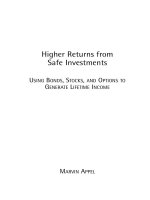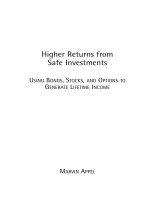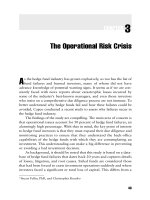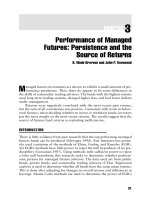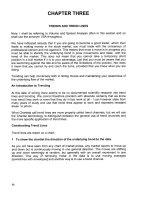Slides_Fundamentals of Investments - Chapter 3 doc
Bạn đang xem bản rút gọn của tài liệu. Xem và tải ngay bản đầy đủ của tài liệu tại đây (513.28 KB, 27 trang )
3
3
C h a p t e r
Security TypesSecurity Types
second edition
Fundamentals
of
Investments
Valuation & Management
Charles J. Corrado Bradford D.Jordan
McGraw Hill / Irwin Slides by Yee-Tien
(Ted) Fu
© 2002 by The McGraw-Hill Companies, Inc. All rights reserved.
McGraw Hill / Irwin
3 - 2
Security Types
Our goal in this chapter is to
introduce the different types of
securities that are routinely bought
and sold in financial markets around
the world.
Goal
For each security type, we will examine:
c its distinguishing characteristics,
d the potential gains and losses from owning it, and
e how its prices are quoted in the financial press.
© 2002 by The McGraw-Hill Companies, Inc. All rights reserved.
McGraw Hill / Irwin
3 - 3
Classifying Securities
Basic Types Major Subtypes
Interest-bearing
Money market instruments
Fixed-income securities
Equities
Common stock
Preferred stock
Derivatives
Options
Futures
© 2002 by The McGraw-Hill Companies, Inc. All rights reserved.
McGraw Hill / Irwin
3 - 4
Interest-Bearing Assets
Fixed-income securities
Longer-term debt obligations, often of
corporations or governments, that promise to
make fixed payments according to a preset
schedule.
Money market instruments
Short-term debt obligations of large
corporations and governments that mature in
a year or less.
© 2002 by The McGraw-Hill Companies, Inc. All rights reserved.
McGraw Hill / Irwin
3 - 5
Money Market Instruments
Examples: U.S. Treasury bills (T-bills), bank
certificates of deposit (CDs), corporate and
municipal money market instruments.
Potential gains/losses: Fixed future payment,
except when the borrower defaults.
Price quotations: Usually, the instruments are
sold on a discount basis, and only the interest
rates are quoted. So, some calculation is
necessary to convert the rates to prices.
© 2002 by The McGraw-Hill Companies, Inc. All rights reserved.
McGraw Hill / Irwin
3 - 6
Fixed-Income Securities
Examples: U.S. Treasury notes, corporate
bonds, car loans, student loans.
Potential gains/losses:
Î Fixed coupon payments and final payment at
maturity, except when the borrower defaults.
Î Possibility of gain/loss from fall/rise in interest
rates.
Î Can be quite illiquid.
© 2002 by The McGraw-Hill Companies, Inc. All rights reserved.
McGraw Hill / Irwin
3 - 7
Fixed-Income Securities
Price quotations:
CUR NET
BONDS YLD. VOL CLOSE CHG.
NEW YORK BONDS
Corporation Bonds
ATT 7
3
/
4
07 …… 7.8 56 100 +
1
/
4
ATT 8
1
/
8
22 …… 8.6 433 94
1
/
8
+
5
/
8
ATT 8
1
/
8
24 …… 8.7 453 93
3
/
4
–
AT&T, the issuer of the bond.
ATT
The bond’s annual coupon rate. You will receive 8
1
/
8
% of the
bond’s face value each year in 2 semiannual coupon payments.
8
1
/
8
The bond will mature
in the year 2022.
22
© 2002 by The McGraw-Hill Companies, Inc. All rights reserved.
McGraw Hill / Irwin
3 - 8
Fixed-Income Securities
Price quotations:
CUR NET
BONDS YLD. VOL CLOSE CHG.
NEW YORK BONDS
Corporation Bonds
ATT 7
3
/
4
07 …… 7.8 56 100 +
1
/
4
ATT 8
1
/
8
22 …… 8.6 433 94
1
/
8
+
5
/
8
ATT 8
1
/
8
24 …… 8.7 453 93
3
/
4
–
8.6
Current yield =
annual coupon
current price
433
The actual
number of bonds
traded that day.
94
1
/
8
The closing price for
the day is 94.125% of
face value.
The closing price is up by
5
/
8
of
1% from the previous closing price.
+
5
/
8
© 2002 by The McGraw-Hill Companies, Inc. All rights reserved.
McGraw Hill / Irwin
3 - 9
Work the Web
Check out bond basics at:
© 2002 by The McGraw-Hill Companies, Inc. All rights reserved.
McGraw Hill / Irwin
3 - 10
Equities
Preferred stock
The dividend is usually fixed and must be
paid before any dividends for the common
shareholders. In the event of a liquidation,
preferred shares have a particular face value.
Common stock
Represents ownership in a corporation. A
part owner receives a pro rated share of
whatever is left over after all obligations
have been met in the event of a liquidation.
© 2002 by The McGraw-Hill Companies, Inc. All rights reserved.
McGraw Hill / Irwin
3 - 11
Common Stock
Examples: IBM shares, Microsoft shares, etc.
Potential gains/losses:
Î Many companies pay cash dividends to their
shareholders. However, neither the timing nor the
amount of any dividend is guaranteed.
Î The stock value may rise or fall depending on the
prospects for the company and market-wide
circumstances.
© 2002 by The McGraw-Hill Companies, Inc. All rights reserved.
McGraw Hill / Irwin
3 - 12
Preferred Stock
Example: Citigroup preferred stock.
Potential gains/losses:
Î Dividends are “promised.” However, there is no
legal requirement that the dividends be paid, as
long as no common dividends are distributed.
Î The stock value may rise or fall depending on the
prospects for the company and market-wide
circumstances.
Equities
: Price quotations
3 -
13
McGraw Hill / Irwin
@2002 by the McGraw-
Hill Companies Inc.All rights reserved.
© 2002 by The McGraw-Hill Companies, Inc. All rights reserved.
McGraw Hill / Irwin
3 - 14
Work the Web
Are you a Foolish investor? Go to
“Fool School” at:
You can also learn more about the
“ticker tape” at:
and create your own ticker at:
© 2002 by The McGraw-Hill Companies, Inc. All rights reserved.
McGraw Hill / Irwin
3 - 15
Derivatives
Primary asset
Security originally sold by a business or
government to raise money.
Derivative asset
A financial asset that is derived from an
existing traded asset rather than issued by a
business or government to raise capital.
More generally, any financial asset that is
not a primary asset.
© 2002 by The McGraw-Hill Companies, Inc. All rights reserved.
McGraw Hill / Irwin
3 - 16
Derivatives
Futures contract
An agreement made today regarding the
terms of a trade that will take place later.
Option contract
An agreement that gives the owner the right,
but not the obligation, to buy or sell a
specific asset at a specified price for a set
period of time.
© 2002 by The McGraw-Hill Companies, Inc. All rights reserved.
McGraw Hill / Irwin
3 - 17
Futures Contracts
Examples: financial futures, commodity
futures.
Potential gains/losses:
Î At maturity, you gain if your contracted price is
better than the market price of the underlying
asset, and vice versa.
Î If you sell your contract before its maturity, you
may gain or lose depending on the market price for
the contract.
Î Note that enormous gains/losses are possible.
Futures Contracts
Price quotations:
3 -
18
McGraw Hill / Irwin
@2002 by the McGraw-
Hill Companies Inc.All rights reserved.
© 2002 by The McGraw-Hill Companies, Inc. All rights reserved.
McGraw Hill / Irwin
3 - 19
Work the Web
You can download lots of basic
futures information from the
Knowledge Center at:
© 2002 by The McGraw-Hill Companies, Inc. All rights reserved.
McGraw Hill / Irwin
3 - 20
Option Contracts
A call option gives the owner the right, but not
the obligation, to buy an asset, while a put
option gives the owner the right, but not the
obligation, to sell an asset.
The price you pay to buy an option is called
the option premium.
The specified price at which the underlying
asset can be bought or sold is called the strike
price, or exercise price.
© 2002 by The McGraw-Hill Companies, Inc. All rights reserved.
McGraw Hill / Irwin
3 - 21
Option Contracts
An American option can be exercised anytime
up to and including the expiration date, while a
European option can be exercised only on the
expiration date.
Options differ from futures in two main ways:
c There is no obligation to buy/sell the underlying
asset.
d There is a premium associated with the contract.
© 2002 by The McGraw-Hill Companies, Inc. All rights reserved.
McGraw Hill / Irwin
3 - 22
Option Contracts
Potential gains/losses:
Î Buyers gain if the strike price is better than the
market price, and if the difference is greater than
the option premium. In the worst case, buyers lose
the entire premium.
Î Sellers gain the premium if the market price is
better than strike price. Here, the gain is limited
but the loss is not.
Option Contracts
Price quotations:
3 -
23
McGraw Hill / Irwin
@2002 by the McGraw-
Hill Companies Inc.All rights reserved.
© 2002 by The McGraw-Hill Companies, Inc. All rights reserved.
McGraw Hill / Irwin
3 - 24
Investing in Stocks versus Options
Example:
Suppose you have $10,000 for investments. Macron
Technology is selling at $50 per share.
Number of shares bought = $10,000 / $50 = 200
If Macron is selling for $55 per share 3 months later,
gain = ($55 × 200)
–
$10,000 = $1,000
If Macron is selling for $45 per share 3 months later,
gain = ($45 × 200)
–
$10,000 =
–
$1,000
© 2002 by The McGraw-Hill Companies, Inc. All rights reserved.
McGraw Hill / Irwin
3 - 25
Investing in Stocks versus Options
Example: …continued
A call option with a $50 strike price and 3 months to
maturity is also available at a premium of $4.
A call contract costs $4 × 100 = $400, so number of
contracts bought = $10,000 / $400 = 25 (for 25 × 100
= 2500 shares)
If Macron is selling for $55 per share 3 months later,
gain = {($55
–
$50) × 2500}
–
$10,000 = $2,500
If Macron is selling for $45 per share 3 months later,
gain = ($0 × 2500)
–
$10,000 =
–
$10,000
